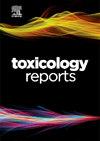Optimization of HPLC method for metanephrine and normetanephrine detection in urine: Enhancing diagnostic precision for pheochromocytoma
Q1 Environmental Science
引用次数: 0
Abstract
Catecholamines and their metabolites play critical physiological roles in the human body. Paragangliomas and pheochromocytomas are rare adrenal tumors that significantly alter catecholamine metabolism, particularly the concentrations of metanephrine (MN) and normetanephrine (NMN). This study presents the development and validation of a rapid and straightforward analytical method using reverse-phase high-performance liquid chromatography (RP-HPLC) coupled with a photodiode array (PDA) detector for quantifying MN and NMN in 24-h urine samples. Sample preparation involved adding 1 mL of urine to a tube containing the internal standard 3-methoxy-4-hydroxy benzylamine hydrochloride (MHBA) and a 2 g/L solution of 2-aminoethyl-diphenylborinate. After vortex mixing and centrifugation, ethyl acetate was used for extraction, and the organic layer was dried under nitrogen at 50–60 °C before reconstitution in the mobile phase. Chromatographic separation was achieved on an RP C-18 column with an isocratic flow of the mobile phase (sodium dihydrogen phosphate, citric acid monohydrate, acetonitrile, and sodium octyl sulfate). Detection was performed at 347 nm, with peak identification based on standard retention times. The method was validated for linearity (10–2000 ng/mL), recovery, sensitivity, precision, accuracy, selectivity, carryover, stability, and dilution effects. It showed a strong correlation coefficient (>0.99) and accuracy within ± 15 %. Inter- and intra-day precision confirmed the method reliability. This validated technique is suitable for clinical and research applications involving catecholamine metabolite screening.
尿中肾上腺素和去甲肾上腺素HPLC检测方法的优化:提高嗜铬细胞瘤的诊断精度。
儿茶酚胺及其代谢产物在人体中起着重要的生理作用。副神经节瘤和嗜铬细胞瘤是罕见的肾上腺肿瘤,它们显著改变儿茶酚胺的代谢,特别是肾上腺素(MN)和去甲肾上腺素(NMN)的浓度。本研究提出了一种使用反相高效液相色谱(RP-HPLC)和光电二极管阵列(PDA)检测器对24小时尿液样本中MN和NMN进行定量分析的快速和直接的分析方法的开发和验证。样品制备包括将1 mL尿液加入一个装有内标3-甲氧基-4-羟基苄胺盐酸盐(MHBA)和2 g/L 2-氨基乙基-二苯硼酸盐溶液的管中。经涡旋混合和离心后,用乙酸乙酯进行萃取,有机层在50-60 ℃氮气下干燥后,在流动相中重构。在RP C-18色谱柱上进行色谱分离,流动相(磷酸二氢钠、一水柠檬酸、乙腈和辛基硫酸钠)等密度流动。在347 nm进行检测,根据标准保留时间进行峰识别。验证了该方法的线性度(10-2000 ng/mL)、回收率、灵敏度、精密度、准确度、选择性、转移、稳定性和稀释效果。其相关系数为>.99,准确度在± 15 %以内。日内、间精密度验证了方法的可靠性。该技术适用于儿茶酚胺代谢物筛选的临床和研究应用。
本文章由计算机程序翻译,如有差异,请以英文原文为准。
求助全文
约1分钟内获得全文
求助全文
来源期刊

Toxicology Reports
Environmental Science-Health, Toxicology and Mutagenesis
CiteScore
7.60
自引率
0.00%
发文量
228
审稿时长
11 weeks
 求助内容:
求助内容: 应助结果提醒方式:
应助结果提醒方式:


